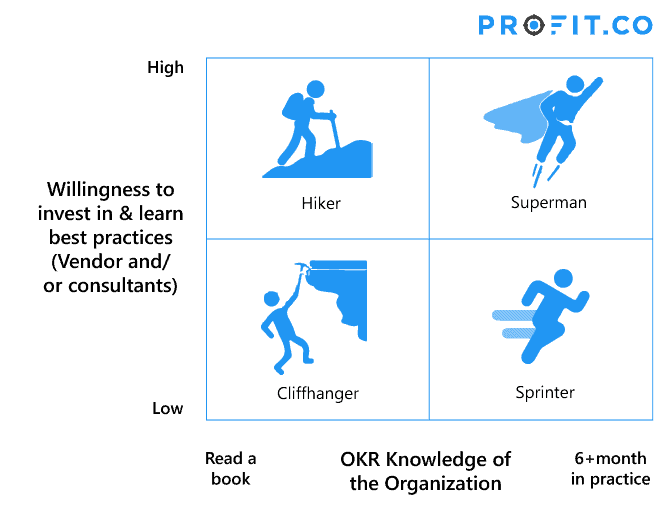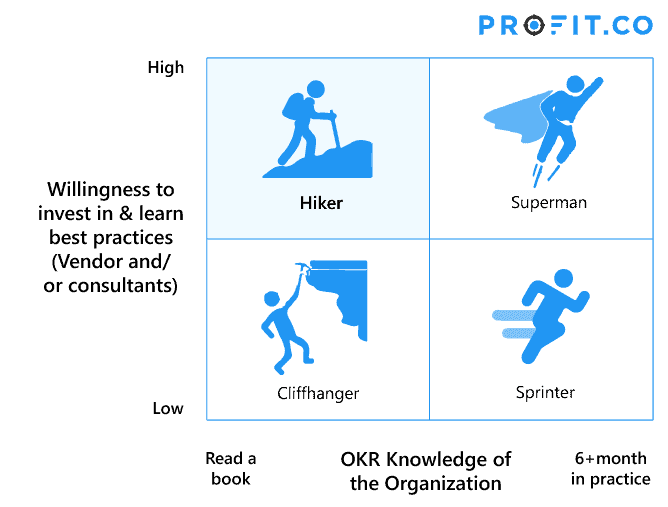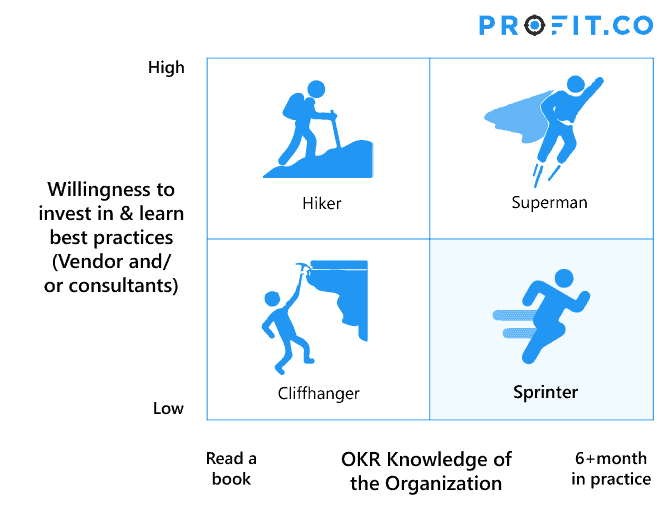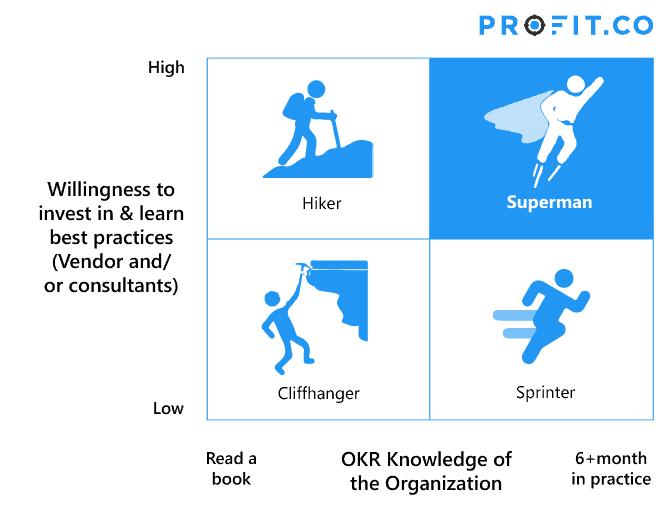
15 Sep Introducing OKRs – Introducing Objectives and Key Results
What you should bear in mind when introducing Objectives and Key Results (OKRs)
Software contributes around 20-25% to the success of an OKR program. In addition to the software, there are many other factors that determine the successful introduction of OKR – Objectives and Key Results. In fact, many people suggest starting with simple Excel sheets and then choosing the right software later.
From working with our customers, we couldn’t agree more. However, we have also learned that if the OKR program fails for any reason, it is usually due to the software. When customers have both an OKR background and introduce Profit.co, they have very high success rates.
To successfully introduce OKRs in your company, two things are particularly important:
- OKR knowledge of the organization
- Willingness to invest in and learn from best practices
From this we can create a 2 X 2 matrix: With OKR knowledge on the X-axis and willingness to invest in best practices on the Y-axis.
Introduce OKRs: The 2×2 matrix
OKR knowledge of the organization ranges from “reading a book” to 6+ months of practical experience. 6+ months OKR practice is classified as very good. We’re not saying that 6+ months of experience makes you an expert. However, you should be familiar with the basics and can easily navigate through the OKR methodology.
Being willing to invest in best practices is all about hiring consultants who can teach you the important basics. When it comes to being recognized by both consultants and Profit.co. In addition to listening to best practice advice, we have experienced situations where key stakeholders ignore and ridicule suggestions. One of these often ridiculed points is the OKR assessment and interpretation. So this is the second important factor. On the one hand, we have a low level of readiness. And on the other hand, we have a high level of willingness.
Q1: Cliffhanger quadrant
So if you are in this lower left quadrant with low to medium readiness in the organization and little OKR knowledge. We would call this a “cliffhanger situation”.
There is really, really not much we can do here. You hear statements like “Okay, we don’t know much about OKR. But we won’t hear any best practices either.” This actually happens quite rarely in practice.
The important point here is that if you feel you are in this quadrant, you should make every effort to get to another one as quickly as possible. Otherwise you should expect many difficulties when introducing OKR.
Q2: Wanderer quadrant
In this quadrant, your current OKR knowledge level is low, but you are willing to listen. We feel very encouraged when clients tell us, “Hey, we really need some help, and we’d like to invest a reasonable amount upfront and learn from your consultants”.
We listen to them, understand their level of knowledge and assess what kind of help they need.
Q3: Ready to Sprint-Quadrant
In the lower right quadrant you will find those whose willingness to listen is low, but who already have good practical experience and OKR knowledge. So you’re already warmed up and ready for the OKR introduction race.
These customers are not arrogant if they have this “low” willingness to learn from best practices. They are only confident about their own current process. They don’t worry about learning from best practices because they have first-hand experience of what has worked and what has not. For them, the problem lies mainly in the choice of software. They actually give us a lot of good advice on how to make certain things more user-friendly, for example. We therefore really enjoy working with customers in this quadrant.
Q4: Superman quadrant
The fourth quadrant is the joy quadrant for us. If there is someone in this quadrant who has a very good practice and is also willing to listen to us, then it is an enriching situation for both of us. That’s why we call this quadrant “Superman” – both for our customers and for us.
When you introduce OKR, you literally fly. And they are able to take advantage of both our product and the OKR methodology itself much more quickly.
Introduce OKRs: Summary
To summarize, it is really difficult to introduce Objectives and Key Results to prospects who are in the “cliffhanger” quadrant.
If we don’t do a good job of looking after our customers and managing expectations to move them into the top left quadrant, the “wanderer” quadrant, you could fall off the cliff at any moment.
We hope that this article has given you an insight into a few issues that you may face when introducing OKR. You can find many more articles on the subject of OKR in our OKR expert magazine.
Are you planning to introduce OKRs in your company? We will be happy to advise you!










